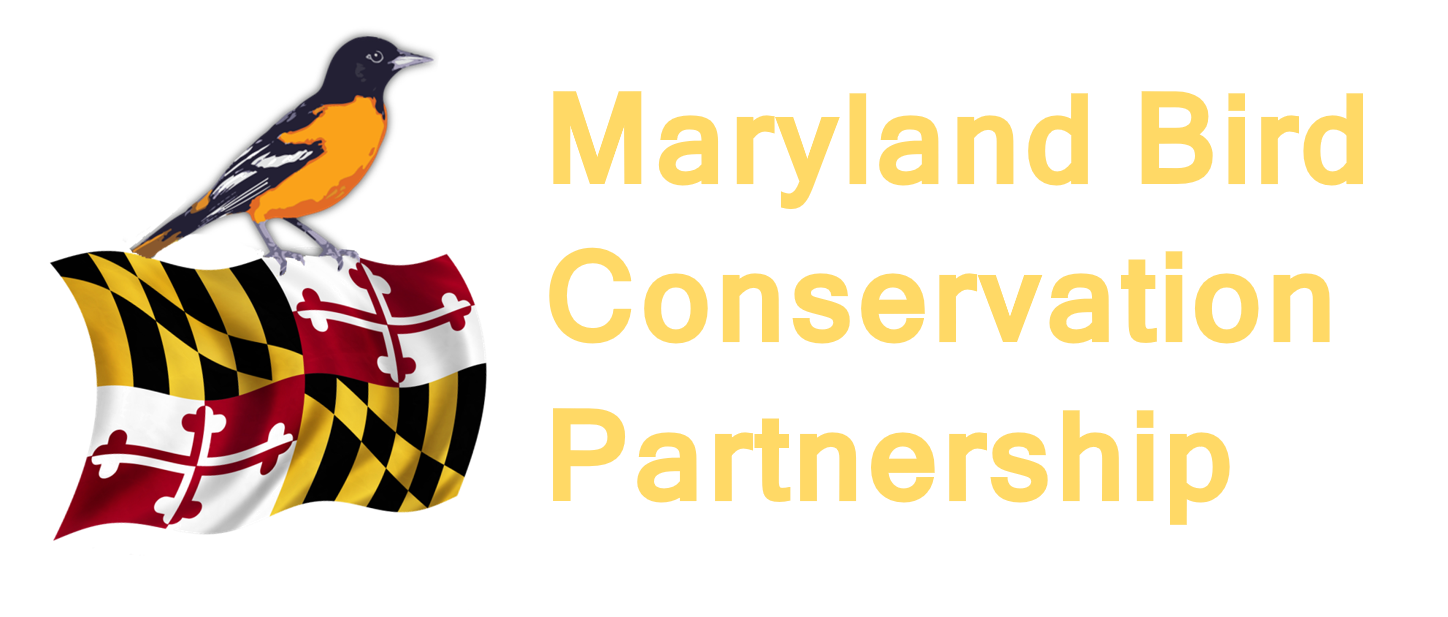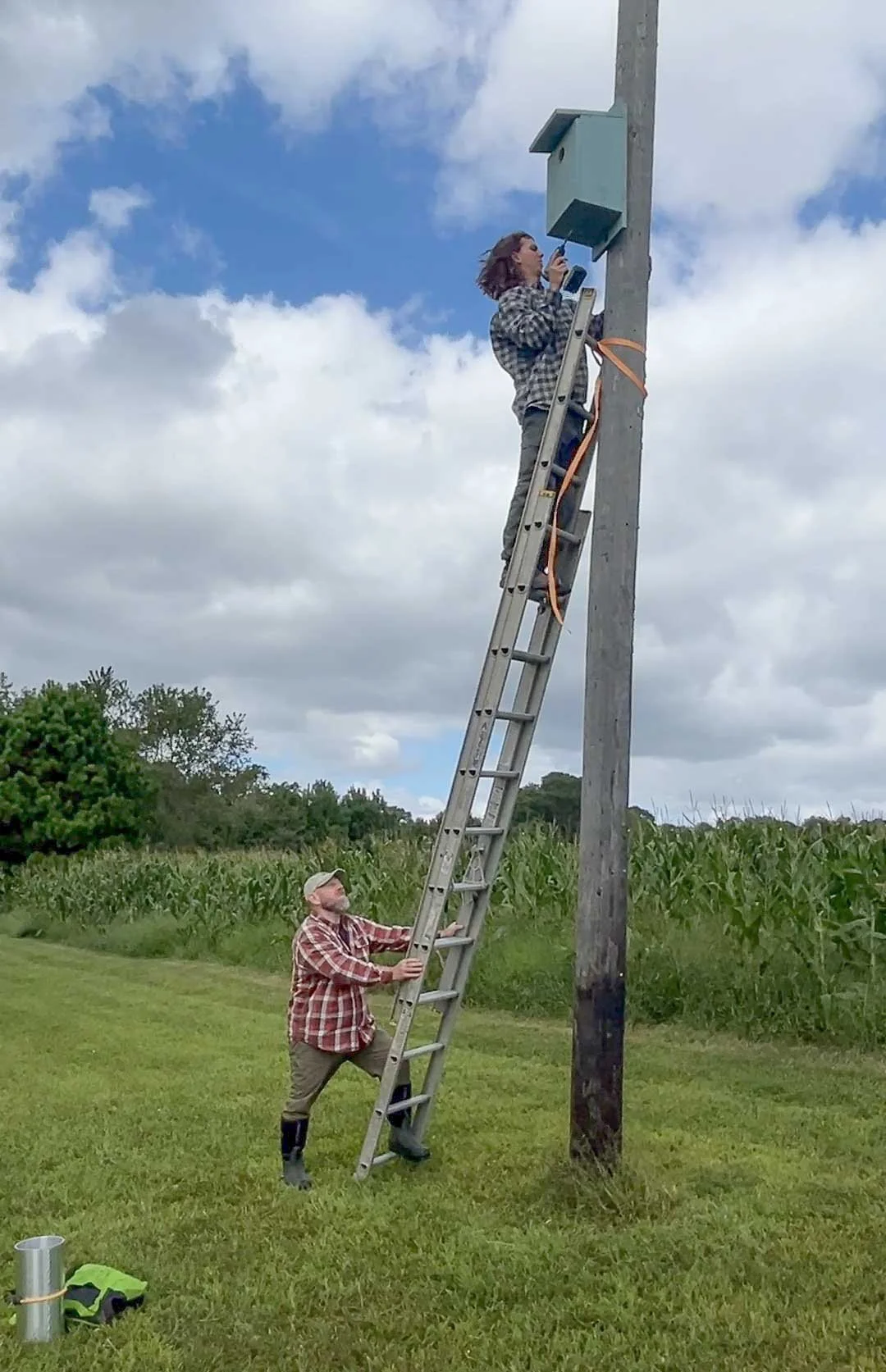This fall, I joined Andy Brown and Alex Pellegrini of the Maryland Farmland Raptor Program (“the program”) on a whirlwind two-day tour of the Lower Eastern Shore. It was meant to be an exploratory trip to identify private lands with habitat suitable for breeding American Kestrels. To my surprise, by the end of the two days, Alex and Andy had installed four kestrel nest boxes, assisted a landowner with plans to build and install a fifth kestrel nest box, and identified at least four more sites for future installations. Our goal? To reverse the decline of the breeding population of this iconic falcon in this region where it has all but disappeared during late spring and summer.
Andy Brown and Alex Pellegrini install an American Kestrel nest box on a farm on the Lower Eastern Shore. Photo by Margaret Poethig
As we drove from one site to the next, we encountered numerous migrating kestrels perched on wires or hovering over the open fields. And yet, kestrels are almost entirely absent during the breeding season on the Lower Eastern Shore, according to data collected during the Maryland and DC Breeding Bird Atlas 3 (BBA3). Atlases are 5-year projects repeated every two decades that document the distributions of Maryland’s breeding birds using a grid of 3x3 mile blocks. In fact, kestrels are declining statewide, likely due to a combination of pesticides, land use changes, reduced prey availability, and even competition with other species.
Kestrels were documented in about 300 blocks during BBA3—a nearly 33% decline in total blocks from the previous breeding bird atlas. When comparing the three atlas maps, one of the areas where this trend is especially evident is the TriCounty area of Wicomico, Worcester, and Somerset counties.
Figure 1. Decline in atlas blocks with American Kestrel
Figure 2. American Kestrel BBA1 breeding distribution (1983–1987)
Figure 3. American Kestrel BBA2 breeding distribution (2002–2006)
Figure 4. American Kestrel BBA3 breeding distribution (2020-2024)
Evaluating Sites for Nest Boxes
We met with landowners or their representatives, as well as local volunteers, expanding on relationships I had established when I served as the Somerset County atlas coordinator. As we walked the properties, Andy and Alex determined whether kestrels might be attracted to the site. If a site met enough criteria, Andy and Alex immediately went to work installing a nest box.
American Kestrel with prey. Photo courtesy of Jonathan Irons
“We were looking for properties with an open landscape, which kestrels like,” said Andy, program manager. “If we saw migrating kestrels on the land, we considered that a good sign.” Since Kestrels feed mainly grasshoppers to their chicks, at least a portion of the land must not be used for row crops, where insecticides are routinely used.
Alex, program coordinator, is responsible for ensuring that the program fulfills the requirements of a National Fish and Wildlife Foundation (NFWF) grant received in collaboration with Hawk Mountain Sanctuary. The goal of the grant is to enhance nesting opportunities for imperiled farmland raptors within the Chesapeake Bay watershed, particularly the American Barn Owl and American Kestrel.
“So, we were also looking for landowners who are doing restoration that will improve the water quality in the Chesapeake Bay watershed,” Alex explained. “But even if a site doesn’t meet that requirement, if we thought it had the potential to support breeding kestrels, we put it on our list for a nest box.”
Recruiting Volunteers
Installing nest boxes is only one step in the program. With the help of volunteers, the program builds nest boxes, monitors nest boxes, bands the chicks produced in the boxes, records nest success, and works with landowners to ensure healthy habitats remain for kestrels. Thus, a crucial goal of the trip was to begin to build the volunteer infrastructure that will be needed to build nest boxes, monitor, and maintain them.
To that end, the first stop was at a farm property in Worcester County, owned by a friend of Eric Liebgold, Professor of Biology at Salisbury University in Wicomico County. Eric readily agreed to help with nest box monitoring and banding on the Lower Eastern Shore, as an extension of the work he and the students in his lab are already doing. Eric has a federally authorized Bird Banding Permit issued by the U.S. Geological Survey’s Bird Banding Laboratory.
Professor Eric Liebgold of Salisbury University (right) and students in his lab, Rachel Stone and Jakob Jones, talk to Andy Brown, while Alex installs a predator guard on the pole. Photo by Margaret Poethig
Jen Barnes of the TriCounty Bird Club, with her pup Mia. Jen will monitor the kestrel box on her friends’ property. Photo by Margaret Poethig
The team also met with Jen Barnes of the Tri-County Bird Club, at a property owned by friends of hers. Andy and Alex quickly determined that the site—fallow fields on the edge of the marsh—was perfect for both a barn owl box and a kestrel box. They immediately installed a kestrel box and decided on the best spot for the barn owl box. Jen agreed to monitor and will be helping to encourage participation in the program among bird club members and their landowner friends.
The program has developed nest box monitoring ethics and guidelines, which emphasize providing as little disturbance to nesting birds as possible and respecting the landowner’s instructions about how to access their land. Volunteers are also asked to track their hours, which counts as “match” for some funding requirements, and not to share the location of nesting raptors with the public.
To help volunteers who want to build nest boxes, I am working with Andy and Alex to produce a series of videos showing how to construct and install both kestrel and barn owl nest boxes.
Connecting Directly with Landowners
Landowner Diane Daniels gestures to frame the scene with moon in the background, as Andy and Alex prepare to install a kestrel box on her driveway. Photo by Margaret Poethig
The program relies on the generosity and willingness of landowners to host kestrel boxes on their land. In return, landowners may get to experience the excitement and joy of having wild birds choose their nest boxes to breed a new generation of kestrels. If nest boxes remain empty, or nesting attempts fail, the program will provide landowners with information about how to improve the habitat on their land for breeding kestrels.
Late on the first day of our trip, by the light of headlamps and the moon, Alex and Andy installed a kestrel box on the driveway of Diane Daniel’s family farm. The farm includes several acres that have been in Maryland’s Conservation Reserve Enhancement Program (CREP) program, a federal state partnership program that pays landowners to take environmentally sensitive cropland out of production and maintain grass, shrubs, trees, or wetlands for the life of the contract. While we were walking the property, we noticed three kestrels hunting over the farm.
Landowners may choose to monitor and maintain the nest boxes themselves or we request that they allow volunteers to access the boxes, with advanced notice of course. Diane’s nephew Julian is planning to monitor and maintain the nest box on the family farm, with training and instruction from the program.
Landowner Lowell Stoltzfus talks to Alex about his Eastern Bluebird nest box success this year. Photo by Margaret Poethig
Lowell Stoltzfus has been building, monitoring, and maintaining Eastern Bluebird and Wood Duck boxes on his property after his retirement from a career in politics. He routinely checks the boxes and documents nesting success. This past year was a bad year for bluebirds, he told us, as we toured his land. Lowell’s stately woods contain numerous open food plot areas, including a very large, open pesticide-free field in the center. Lowell plans to build his own nest box out of cedar (the program’s boxes are typically made of less expensive plywood or pine and then painted), and install it on a pole that he will sink three feet into the ground. Andy helped Lowell pick out the pole and the best spot. In truth, Andy is a bit skeptical about whether the field is large enough to attract kestrels, but we all hope they do come. If Lowell needs support monitoring and maintaining the box, the program will provide it.
More Boxes, and then We Wait
By the end of the two days, I had a pretty good idea of what to look for. I took Andy and Alex by several other sites whose owners had supported the atlas. They agreed that many of them had potential to support breeding kestrels. We returned home, with a list of landowners to follow-up with. Over the winter we will return to the Lower Eastern Shore to install more nest boxes, and then begins the wait for the hoped-for return of the kestrels.











